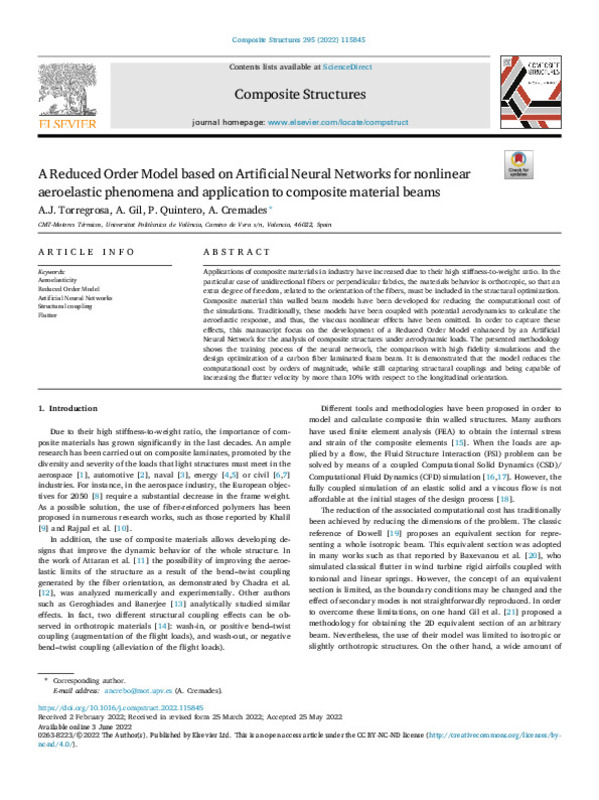JavaScript is disabled for your browser. Some features of this site may not work without it.
Buscar en RiuNet
Listar
Mi cuenta
Estadísticas
Ayuda RiuNet
Admin. UPV
A Reduced Order Model based on Artificial Neural Networks for nonlinear aeroelastic phenomena and application to composite material beams
Mostrar el registro sencillo del ítem
Ficheros en el ítem
| dc.contributor.author | Torregrosa, A. J.
|
es_ES |
| dc.contributor.author | Gil, A.
|
es_ES |
| dc.contributor.author | Quintero-Igeño, Pedro-Manuel
|
es_ES |
| dc.contributor.author | Cremades-Botella, Andrés
|
es_ES |
| dc.date.accessioned | 2023-09-08T18:00:52Z | |
| dc.date.available | 2023-09-08T18:00:52Z | |
| dc.date.issued | 2022-09-01 | es_ES |
| dc.identifier.issn | 0263-8223 | es_ES |
| dc.identifier.uri | http://hdl.handle.net/10251/196137 | |
| dc.description.abstract | [EN] Applications of composite materials in industry have increased due to their high stiffness-to-weight ratio. In the particular case of unidirectional fibers or perpendicular fabrics, the materials behavior is orthotropic, so that an extra degree of freedom, related to the orientation of the fibers, must be included in the structural optimization. Composite material thin walled beam models have been developed for reducing the computational cost of the simulations. Traditionally, these models have been coupled with potential aerodynamics to calculate the aeroelastic response, and thus, the viscous nonlinear effects have been omitted. In order to capture these effects, this manuscript focus on the development of a Reduced Order Model enhanced by an Artificial Neural Network for the analysis of composite structures under aerodynamic loads. The presented methodology shows the training process of the neural network, the comparison with high fidelity simulations and the design optimization of a carbon fiber laminated foam beam. It is demonstrated that the model reduces the computational cost by orders of magnitude, while still capturing structural couplings and being capable of increasing the flutter velocity by more than 10% with respect to the longitudinal orientation. | es_ES |
| dc.description.sponsorship | This project have been partially funded by Spanish Ministry of University through the University Faculty Training (FPU) program with reference FPU19/02201. | es_ES |
| dc.language | Inglés | es_ES |
| dc.publisher | Elsevier | es_ES |
| dc.relation.ispartof | Composite Structures | es_ES |
| dc.rights | Reconocimiento - No comercial - Sin obra derivada (by-nc-nd) | es_ES |
| dc.subject | Aeroelasticity | es_ES |
| dc.subject | Reduced Order Model | es_ES |
| dc.subject | Artificial Neural Networks | es_ES |
| dc.subject | Structural coupling | es_ES |
| dc.subject | Flutter | es_ES |
| dc.subject.classification | INGENIERIA AEROESPACIAL | es_ES |
| dc.subject.classification | MAQUINAS Y MOTORES TERMICOS | es_ES |
| dc.title | A Reduced Order Model based on Artificial Neural Networks for nonlinear aeroelastic phenomena and application to composite material beams | es_ES |
| dc.type | Artículo | es_ES |
| dc.identifier.doi | 10.1016/j.compstruct.2022.115845 | es_ES |
| dc.relation.projectID | info:eu-repo/grantAgreement/MIU//FPU19%2F02201//AYUDA PREDOCTORAL FPU-CREMADES BOTELLA. PROYECTO: INTERACCIÓN FLUIDO ESTRUCTURA CON APLICACIÓN A FENÓMENOS AEROELÁSTICOS NO LINEALES/ | es_ES |
| dc.rights.accessRights | Abierto | es_ES |
| dc.contributor.affiliation | Universitat Politècnica de València. Escuela Técnica Superior de Ingeniería del Diseño - Escola Tècnica Superior d'Enginyeria del Disseny | es_ES |
| dc.description.bibliographicCitation | Torregrosa, AJ.; Gil, A.; Quintero-Igeño, P.; Cremades-Botella, A. (2022). A Reduced Order Model based on Artificial Neural Networks for nonlinear aeroelastic phenomena and application to composite material beams. Composite Structures. 295:1-15. https://doi.org/10.1016/j.compstruct.2022.115845 | es_ES |
| dc.description.accrualMethod | S | es_ES |
| dc.relation.publisherversion | https://doi.org/10.1016/j.compstruct.2022.115845 | es_ES |
| dc.description.upvformatpinicio | 1 | es_ES |
| dc.description.upvformatpfin | 15 | es_ES |
| dc.type.version | info:eu-repo/semantics/publishedVersion | es_ES |
| dc.description.volume | 295 | es_ES |
| dc.relation.pasarela | S\481668 | es_ES |
| dc.contributor.funder | Ministerio de Universidades | es_ES |
| dc.contributor.funder | Universitat Politècnica de València | es_ES |








